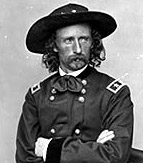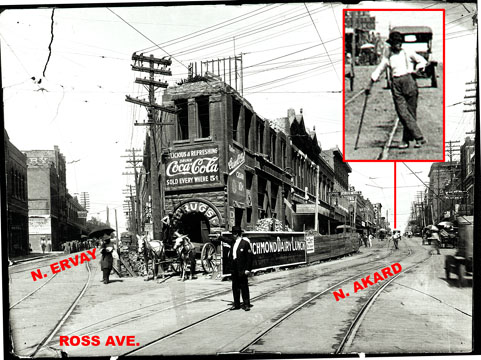|

Join Our Mailing List |
| Custer & Dallas |
 |
How does Dallas have any connection with George Armstrong Custer? Well, it does, sort of! Custer's disastrous encounter with Plains Indians in 1876 during the country's 100th birthday celebration captured the imagination and passions of that generation and everyone since. Disbelieving Dallas citizens reacted. And today, thanks to author James Donovan, we know more about Custer than Custer.
On that fateful June 25, 1876, George Armstrong Custer and over 200 of his men met their end in the hills overlooking the Little Bighorn River in a running fight against an overwhelming force of Sioux, Cheyenne and other Plains Indians. Custer, the fabled Civil War Union cavalry leader and an Indian fighter, had three direct connections to Dallas. The first, the 7th Cavalry, commanded by Lt. Col. Custer, was stationed in Texas following the Civil War in 1867 to help maintain order. On August 3 the Dallas Daily Herald reported a squad from the 7th was in town to aid William Horton, the Freedmen's Bureau's agent in Dallas. There was no great love affair between the Bureau and the Dallas folks as Horton said he needed soldiers to help keep the peace. So, according to the local newspaper, troops from the 7th Cavalry were in Dallas.
The second, as soon as Dallas citizens learned of Custer's 1876 defeat, a public meeting was held in early July at the Court House. Recalling the days when "forays of hostile Indians" roamed near the Dallas frontier, the meeting lamented the "calamity" that had "befallen our frontier in the loss of so gallant, high toned and magnanimous an office as Gen. Custar [sic]." President Grant was blamed for the disaster. In reaction to the Custer defeat, Mayor William Cabell, himself a Confederate veteran, offered to raise a brigade of troops to fight the Sioux and Cheyenne but his offer was gently declined by General William T. Sherman.
As emotions apparently still ran high, a third connection was made. A short lived militia company, the Custer Light Horse Cavalry, was organized on August 12 as a "tribute to the memory of a gallant and lamented soldier." Forty-seven men joined the ranks led by D. E. Grove. However, the troop's ardor soon waned and in February 1877 the local paper humorously reported: "The Custer Light Horse has made its last charge."
But, now there is a more modern Dallas connection with Custer. James Donovan, who lives in Dallas, has written a definitive history of George Armstrong Custer and his exploits on the American plains. A Terrible Glory: Custer and the Little Bighorn, The Last Great Battle of the American West is a thorough discussion of the background leading to the battle, the major personalities in both the military and Indians, the recriminations that flowed following the Custer disaster, the mix of civilian and military politics and the public hearing given to Major Marcus Reno. Donovan's recounting of what happened to so many of the main characters in this drama indicates that if they had lived today, they would have redefined post traumatic stress disorder. Connecting Custer with Dallas might be a stretch but Donovan's book is a good read.
-Dr. Tom Smith |
|
Welcome,
...to the July issue of the Dallas Historical Society Newsletter. We sincerly hope you enjoy it. If you have missed any of our previous newsletters and would like to browse them, please click here. |
|
|
Matinees are Back!
Saturday, July 26th DHS will be showing the 1964 classic "Zulu" starring Michael Caine. Ed Owens will be on hand to deliver a "reel vs. real" lecture on the film and to show several uniforms and items of the period. The film will be showing in the auditorium at the Hall of State at 11:00 AM. Lecture and film will be open to the public.
|

Being a history nerd, I have long grumbled that Dallas does not have much in the way of historic sites. No looming castle shrouded in mist or great battlefield where the course of history was changed. I complain that every time some old building begins to show signs of becoming vaguely historic, it is pulled down. However, I am beginning to think that maybe I am being a little unfair. Dallas has always been in the process of rebuilding itself. It might be our more distinctive feature.
A book I enjoy is "Civil War Battlefields, Then and Now", by James Campi. The author had a great idea: he took a collection of famous Civil War photographs and tried to find the exact spot where the nineteenth century photographer stood. The point was to show how much had changed in 140 years.
Working in the archives is a lot like that. For example, I know the streets around the Old Red Courthouse very well. The other day I came across a shot of the original Dallas Morning News building on Main Street. It used to sit where El Central College is now, I knew the photograph was taken on the corner of Austin and Main Streets. Did you know that where the JFK Memorial stands today, is the approximate location of where Doc Holiday began his career as a gunfighter back in the 1870s? Sometimes I think I remember Houston Street before it was paved.
This month I thought it might be fun to share my time travels with you. This photograph was taken about 1915. Make a copy of it for yourself(right click and save to desktop). The next time you visit the Dallas Museum of Art, walk over to the Fairmont Hotel, stand on the corner of Ross and Akard and look across the street. What a difference 93 years make. You will also note that I have enlarged a small section of the photo, I will let you write your own caption for this one.
There is very little left of Dallas from 100 years ago, I will let you decide if that is a good thing or not. As for me, I am afraid that someday someone is going to call my wife and tell her that I was found down on Commerce Street trying to book a room at the Oriental Hotel and complaining loudly about the infrequent trolly stops.
-Ed Owens
|
|
|
If we may be of service to you in the future with discovering our past feel free to contact, visit or join the DHS.
Sincerely,
Dallas Historical Society
|
|
|